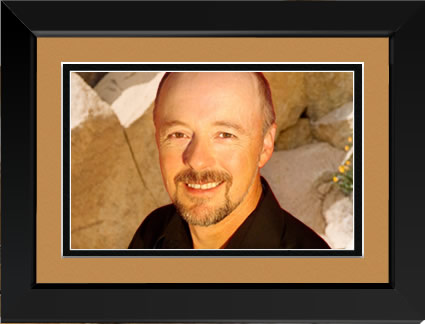In Profile: Dr. Clint Boal
How Predatory Birds Adapt to Our Modern World
Dr. Clint Boal is an ornithologist specializing in raptors. Most of his works revolves around the interactions between these charismatic species and humans. With a gesture toward his office window which overlooks the evenly spaced trees below he describes one such encounter that he recently observed.
 It is towards the end of the passing period and the sidewalks, lawns, and streets
of Texas Tech University are getting quiet again as the start of 10:00 O'clock classes
draws near. A young woman hurries across the shady quad toward the Chemistry building,
her attention focused on the cell phone in her hand. Unfortunately her path takes
her a little too close to the mature Honey Locust tree. From out of the mass of leaves
a slim pale shape swoops toward the texter. The woman lets out a surprised yelp and
ducks her head when she feels the rush of wind from the downstroke of wings as the
bird passes closely over her head. Hand raised to ward off further attack, she dashes
for the arch covered walkway in a burst of startled adrenaline.
It is towards the end of the passing period and the sidewalks, lawns, and streets
of Texas Tech University are getting quiet again as the start of 10:00 O'clock classes
draws near. A young woman hurries across the shady quad toward the Chemistry building,
her attention focused on the cell phone in her hand. Unfortunately her path takes
her a little too close to the mature Honey Locust tree. From out of the mass of leaves
a slim pale shape swoops toward the texter. The woman lets out a surprised yelp and
ducks her head when she feels the rush of wind from the downstroke of wings as the
bird passes closely over her head. Hand raised to ward off further attack, she dashes
for the arch covered walkway in a burst of startled adrenaline.
The surprised texter has just had her first encounter with a Mississippi Kite defending its nest. Dr. Boal explains that these small, elegant raptors thrive in our urban habitat matrix. They are a species that benefits from people being here. Since they require mature trees for nesting they normally would not even be in our shrub and grassland dominated landscape. Dr. Boal and his research team are trying to understand the Kite's choices of nesting sites and the factors that influence their aggression with the goal of reducing the occurrence of negative interactions between Kites and their human neighbors.
The Mississipi Kite is a pretty unique case. Many raptors struggle to adapt to human caused changes in the landscape. With the upsurge in wind energy installations in recent years, Dr. Boal is trying to understand how closely spaced fields of huge, continuously moving, windmills influence habitat use in a diversity of species.
From resident Golden Eagles to migrating Swainson's Hawks, his team wants to know how they navigate through, and interact with, wind farms and how we can mitigate the impact of these structures. He explains that it is hard to predict the outcome of new installations because of the different ways these birds divide up their use of the airspace and how they hunt. Open country raptors require large territories to hunt in; they may avoid areas with wind turbines which, thereby, turns what was once good habitat into unsuitable areas with a resulting net loss of habitat. If they do not avoid the areas, they may be subject to direct mortality by colliding with the turbine blades.
Along the Texas coast White-tailed Hawks face different challenges. They inhabit the barrier islands and coastal prairies which are increasingly being converted to cropland or are undergoing urbanization. Dr. Boal's team wants to understand if this species, which is rare in the United States, can tolerate such disturbances.
Though raptors are his first love, Dr. Boal also studies other species which show signs of disappearing in impacted areas. One of the most conspicuous, primarily because of its candidacy for protection as an endangered species, is the Lesser Prairie-Chicken. Among biologists this animal is best known for its tendency to form concentrated male groups called leks. Lekking males compete for females by engaging in vocal and physical displays. Leks are central to the species reproductive ecology and locations don't move much from year to year; thus, any changes in the local landscape, such as conversion to agriculture or development of petroleum or wind energy facilities may have negative consequences for the species. Other factors that impact Chicken populations such as predation, nesting success, heat and humidity tolerances of eggs, and adult winter survival are also being looked at.
Dr. Boal says the most important skills for students wanting to enter his field to cultivate are professionalism, objectivity, and integrity. Since so much of his work has the potential to impact the lives and bottom lines of people and corporations he emphasizes the importance of biologically sound decision making.
Dr. Boal explains that he is a research faculty member in the Fish and Wildlife Cooperative Research Unit here at Texas Tech so he primarily teaches graduate classes. However he still really enjoys mentoring undergraduates. He usually has 4-6 undergraduate students working on research projects in his lab, and is frequently looking for more. He adds that most of the undergraduate positions are paid and says that a "curiosity" about the natural world, enthusiasm for field work, and reliability are the most important qualifications.
Written by Kate LeVering in collaboration with Clint Boal
CONTACT: Clint Boal, Department of Natural Resources Management, Texas Tech University
at (806) 834 - 6536 or Clint Boal
MORE INFO Boal Lab Website
Department of Natural Resources Management
-
Address
Goddard Building, Texas Tech University, Box 42125, Lubbock TX 79409 -
Phone
806.742.2841 -
Email
nrm@ttu.edu
